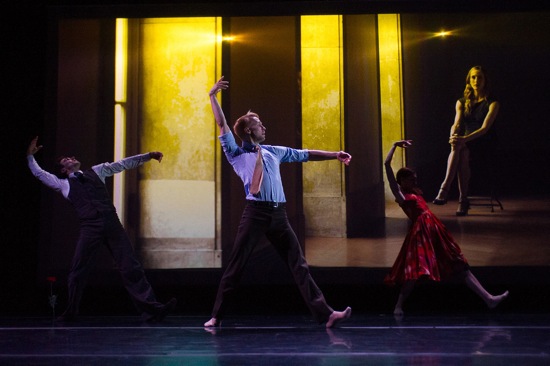
L to R: Jens Weber, Pontus Lidberg, and Gabrielle Lamb of Morphoses in Lidberg’s Within (Labyrinth Within). On film: Wendy Whelan. Photo: Christopher Duggan
When Christopher Wheeldon founded a dance company in 2007 and called it Morphoses/the Wheeldon Company, he couldn’t have known how prophetic that name would become. From the beginning, the repertory balanced works by Wheeldon, one of the most gifted choreographers of his generation, with those by other youngish artists. Three years later, Wheeldon left Morphoses after a serious dispute over the company’s direction and organization with its executive director, Lourdes Lopez, taking his name and ballets with him. At this point, the ongoing developments implied by the term “morphoses” took a new form.
Lopez, a former principal dancer with New York City Ballet, is interested in cross-disciplinary collaborations with dramatic heat, and each year, the company—essentially a pick-up group with some loyal regulars— is handed over to a different resident choreographer and project. Last year, Morphoses produced Luca Veggetti’s Bacchae; this year’s guest is the Swedish choreographer Pontus Lidberg.
Now the company is about to enter a new phase. Last April, Lopez was chosen to replace Edward Villella as artistic director of the Miami City Ballet, a company committed to a repertory that features many Balanchine ballets, and one with a reputation for presenting them wonderfully. As I understand it, Lopez plans to take Morphoses—in some form—with her to Miami as a kind of experimental wing of the MCB. Stay tuned.
The project developed by Lidberg in 2012 premiered at Jacob’s Pillow last June and appeared at the Joyce in New York November 7 through 11. Its name, Within (Labyrinth Within), reflects its history. In 2010, Lidberg, a film director as well as a performer and choreographer, created a 28-minute film, Labyrinth Within, which subsequently won prizes at two film festivals. This movie about a man obsessed by the thought that his wife may be unfaithful and the lover who may exist only in his imagination forms the second half of performance. Lopez apparently asked Lidberg to consider creating a kind of analogue to the film that could precede it onstage.
Labyrinth Within stars the New York City Ballet’s remarkable Wendy Whelan as the wife, dancer-choreographer Giovanni Bucchieri as the increasingly unbalanced husband, and Lidberg as her possible lover. The film is beautiful to look at. Most of it was shot in a castle outside Stockholm. A chill, wintry light slants into a long train of nearly empty rooms with bleached wood floors. No one speaks. The interplay of rapid cuts and meaningful close-ups (like the shot of Bucchieri’s wedding-ringed hand) helps convey the basic facts of the tale, but it also deliberately skews time, so you’re never entirely sure what precedes what, or what is real and what imagined.
Clearly the marriage between Whelan, wearing a little black dress and high-heeled shoes, and Bucchieri’s business-suited businessman (or professor), with his warm lair of an office, has lost its luster (shot of the two in bed, well-separated). But when she secretively opens an unlikely door in one of the great halls and disappears into darkness, she reappears on the other side in a room with a rug and Lidberg. At this point, you may have to suspend your interpretation of reality. You must not allow yourself to think, “This woman isn’t having an affair; she’s having a pas de deux.”
What’s the problem? After all, we understand a pas de deux in a ballet (or some pas de deux in some ballets) as being a symbol of courtship, love, and/or sex. Whelan (now shoeless) and Lidberg perform intricate maneuvers around each other’s bodies, rolling over and sliding under the arches and apertures created by their changing positions. The camera avoids Lidberg’s face, thereby denying him agency and reinforcing his status as an imaginary lover. The smooth fluidity of the duet—much of it on the floor—gives it a dreamlike quality, although the stray arabesque or tricky lift can draw you momentarily right out of the boudoir and onto a stage. The pair’s second duet is steamier (Whelan has taken off her dress), but when Bucchieri arrives, knife in hand, she’s alone, her usual cool, brisk self. And, as if his fantasy has somehow revitalized their marriage, they embrace and seal the reconciliation with. . .what else?. . .a pas de deux.
Lidberg, the director, and photography director Martin Nisser build suspense through their repeated images and angles. The husband phones; no one answers. In an ensuing scene, the wife’s telephone rings; she ignores it. Both husband and wife are shown at separate times walking up the stairs to their opulent but symbolically barren home, gazing upward as if to divine a presence or looking backward (perhaps someone is following). A poppy that the husband carries may signify his delusional state of mind. Poppies spring through the floorboards.
The fine music, by David Lang, recorded by the Norrlandsoperan Symphony Orchestra, with cellist Maya Beiser, tracks the scenario’s emotional climate, from spare, echoing tones and long silences to tempestuous passages for the orchestra and singing ones drawn from the cello.
The performances are excellent. We divine what the two are thinking through their gazes, their rhythms, and the ways in which they hold themselves. Bucchieri conveys a range of strong emotions subtly, and Whelan—luxuriant in her dancing, of course—portrays the frozen wife convincingly without overt “acting.” Lidberg—a cypher emotionally—is physically alluring, lowering and angling himself to entice her into bolder entanglements.
After I’d seen the whole performance, the new onstage half, with its background of film images, assumed more meaning: a possible abstraction of the dramas that shape the 2010 film. But Lidberg was also making, I think, a statement about reality and illusion, about the relationship between action seen on film and that experienced in a theater. The scrim onto which images are projected can also be transparent, so that encounters and solos can occur behind it, as well as on it or in front of it. The dancers can perform in unison with their virtual selves or in counterpoint to them.
These are exceptional dancers, with more varied backgrounds than I can provide in full here: Isabella Boylston, American Ballet Theater soloist (she replaced Frances Chiaverini, now with the L.A. Dance Project, in Lidberg’s work); Laura Mead, veteran of two Twyla Tharp musicals, who alternates with Boylston; Gabrielle Lamb, a Morphoses dancer since 2007 and a choreographer and video artist herself; Adrian Danchig-Waring, a soloist with the New York City Ballet; and Jens Weber, whose various jobs have included that of principal dancer with the Berlin Ballet. Karen Young designed their costumes.
Lidberg himself has the most prominent part in this prequel to the film. Here, too, the lighting (by Lidberg with Carolyn Wong) is cool, and the single notes and long silences in Lang’s score for this new section of Within might as well be echoing in the empty rooms shown in the film. What is Lidberg thinking? It’s impossible to tell. In his long (perhaps overly long) opening solo, he doesn’t show us his face, and he has a thing about the floor. Moving between and among the red flowers planted here and there, he sinks deeply, lunges, spins, and rolls— his head rarely more than two feet off the ground. His smoothness amounts to virtuosity; when he takes long, low steps around the stage, its surface become a frozen pond.
Soon, we also see him onscreen, performing what might be the same dance on a platform surrounded by forest, and, briefly, standing and staring out to sea. It occurs to me that he may not represent the lover in the film now, but himself, the choreographer, working out ideas in his head.
The other performers make their first appearance as stagehands, removing some of the poppies. They do so, in part, to make room for a slow, controlled, elaborate tangling around one another, but in later passages, their movements hint at the emotions in the film. Lamb and Weber dance together both onstage and on film (in one of the castle’s rooms) sometimes out of synch with their images. Does she want him? Does she not? She isn’t sure. It’s as if these dancers are avatars of the discontented husband and wife,
Boylston is linked to the wife’s “other” self, and Danchig-Waring represents the lover. Their slippery embraces are intimate but without heat. His hair falls across his face, so that it’s hard to see what he might be thinking. However, when onstage, all four dancers seem beyond desire, their gazes often indirect or veiled. I find this puzzling. It has the effect of neutralizing what they do—as if the choreographer were pulling the strings of some fabulous puppets.
Boylston and Danchig-Waring move both in front of the screen and behind it. Oddly, the scrim doesn’t touch the floor, so you may see a dancer’s legs and feet before the “wall” becomes transparent. Once, Lamb dances on one side of it and Boylston on the other, duplicating, but not mirroring each other’s steps. A mirror in the filmed house adds to the mysteries of identity and motives.
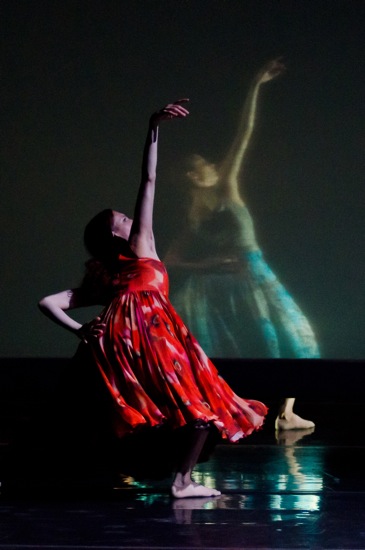
Gabrielle Lamb (L) and Frances Chiaverini in the Jacob’s Pillow performance. Photo: Lisa Voll, courtesy of Jacob’s Pillow
My sense of Lidberg’s role becomes stronger shortly before Whelan appears on film (to be introduced before the film proper begins); she’s wearing her black dress, sitting on a chair, and staring out at us. All five dancers are onstage, tangling yet again in innumerable inventive ways. Lidberg moves seamlessly back and forth between the clustered duets—now making this one into a trio, now allying himself with that one. He may be both the dream lover who intrudes into unfulfilling marriages and the choreographer meditating on what constitutes intimacy in a danced relationship.
When Labyrinth Within ends on the screen, the dancers walk onstage. The two men wheel the scrim further upstage. But there’s to be no more dancing in this enigmatic, morphosing work, not even a brief conclusion. The performers are simply making room for a proper curtain call. You want to call out, “and then???”

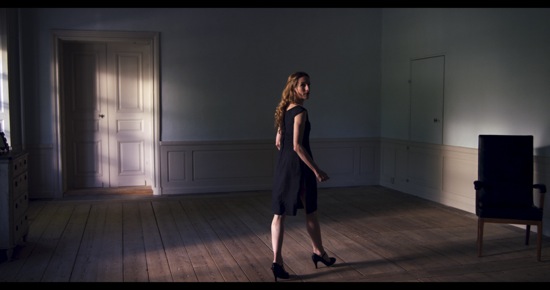


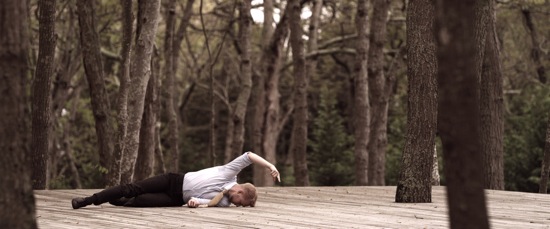
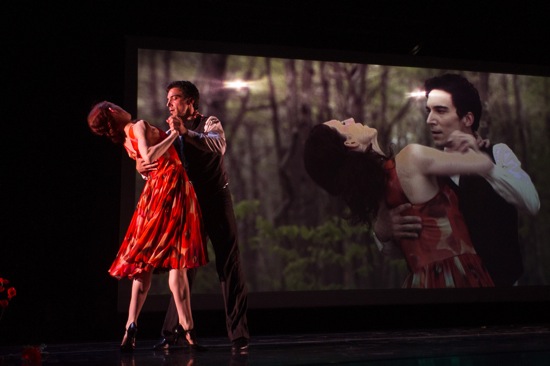
Dear Deborah,
As ever, I appreciate your remarkable ability to bring the felt experience of being in the audience into words, onto the “page” and into my felt experience as a reader. I don’t know how you do it. Again and again I feel as though I have a clear view of the work, channeled through your sensibility and writing.
Thank you!
Christopher
I must add my own hosannas to Mr. Pilafian’s comments, and also say I hope Mr. Lidberg realizes how very lucky he is to have such thoughtful, vividly written analysis of his work. Oregon Ballet Theatre is presenting a new ballet of his in the spring; Deborah’s review here gives me invaluable information and background, as well as a damn fine read.
I think this is one of the most significant info for me.
And I’m glad reading your article. But want to remark on some general things, The website style is ideal, the articles are really nice : D. Good job, cheers
Woah! I’m really enjoying the template/theme of this site. It’s simple,
yet effective. A lot of times it’s hard to get that “perfect balance” between superb usability and visual appeal. I must say you have done a fantastic job with this. Also, the blog loads super fast for me on Internet explorer. Superb Blog!